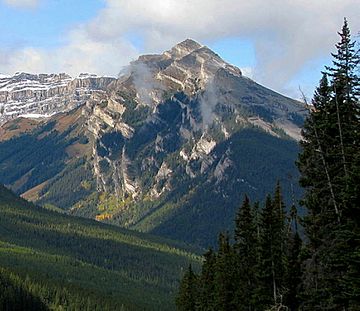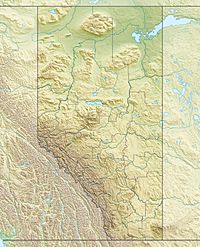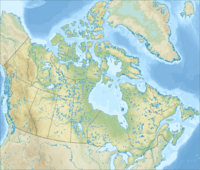Massive Mountain facts for kids
Quick facts for kids Massive Mountain |
|
|---|---|

Massive Mountain
|
|
| Highest point | |
| Elevation | 2,435 m (7,989 ft) |
| Prominence | 88 m (289 ft) |
| Parent peak | Mount Brett |
| Listing | List of mountains of Alberta |
| Geography | |
| Location | Alberta, Canada |
| Parent range | Massive Range Canadian Rockies |
| Topo map | NTS 82O/04 |
Massive Mountain is a cool peak located in Banff National Park in Alberta, Canada. It's part of the Massive Range. People named it in 1918 because it looks super big! Even though it's huge, it's not the tallest mountain in its range. That title goes to Mount Brett, which is much higher at 2,984 meters (9,790 feet).
Contents
How Massive Mountain Was Formed
Rocks and Layers: A Look at Geology
Massive Mountain is made up of sedimentary rock. Think of sedimentary rock as layers of sand, mud, and tiny bits of old shells that piled up over millions of years. These layers were laid down during ancient times, from the Precambrian period all the way to the Jurassic period.
The Big Push: Mountain Building
These rock layers formed at the bottom of shallow seas. But then, something amazing happened! During a time called the Laramide orogeny (say: La-ra-mide Or-oh-jen-ee), huge forces pushed these rocks. It was like giant hands pushing the Earth's crust. This pushing made the rock layers move east and even slide over younger rocks. This is how Massive Mountain, and many other mountains in the Canadian Rockies, were created!
Weather at Massive Mountain
Understanding the Climate Zone
Massive Mountain is in a subarctic climate zone. This is based on something called the Köppen climate classification system, which helps scientists describe different climates around the world. A subarctic climate means it has very specific weather patterns.
Cold Winters and Mild Summers
If you visit Massive Mountain, expect cold and snowy winters. Temperatures can drop below -20 degrees Celsius (that's -4 degrees Fahrenheit!). With the wind blowing, it can feel even colder, sometimes below -30 degrees Celsius (-22 degrees Fahrenheit)! Summers, however, are much milder and more pleasant.




